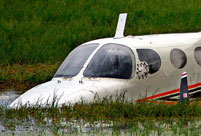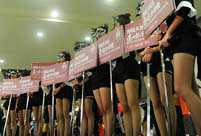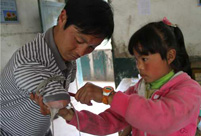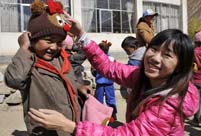V. Social Changes and Development of All Undertakings
Tibet has achieved all-round development. With the changes in the political and economic systems, Tibet has made the transition from a traditional society to a modern one. Its people' s rights to education, employment, health and social security have been further protected, and all social undertakings are thriving.
Science and education have achieved rapid development.
Before its peaceful liberation in 1951, Tibet had no scientific research institutes or staff in the modern sense except in the areas of Tibetan medicine, astronomy and the calendar. Now, Tibet has 33 state-owned independent scientific research institutes, ten private scientific research institutes, and 184 agricultural and animal husbandry science and technology promotion organizations at the autonomous region, prefectural (municipal), and county (district)levels; 29 agricultural science and technology parks and key laboratories at the national and autonomous region levels; 27 state-level new and high-tech enterprises and 46 autonomous-region-level small and medium-sized sci-tech enterprises, and five state-level innovative enterprises and corporate technology centers. Currently, Tibet has 56,264 technical professionals, of whom 43,552 are from ethnic-minority groups, accounting for 77.41 percent; 2,870 senior technical professionals (including one member of the Chinese Academy of Engineering, 244 experts enjoying special government allowances, 16 young and middle-aged experts with outstanding contributions and three national outstanding technical professionals), 13,869 intermediate technical professionals and 36,216 junior technical professionals. All these people play an active role in scientific innovation and application in agriculture, animal husbandry, industry, Tibetan medicine, new energy, tourism, cultural creativity, ethnic handicrafts and other fields. In 2012 the contribution rate of science to economic growth reached 35 percent, to agricultural and animal husbandry growth 42 percent, and the popularization rate of science and technology 85 percent.
Before the peaceful liberation of Tibet, the educated were mostly aristocrats, while serfs and slaves, accounting for 95 percent of the total population of Tibet, had no right to education at all, and the illiteracy rate among young and middle-aged people was 95 percent. Now, Tibet has established a modern education system covering pre-school education, basic education, vocational education, higher education, adult education and special education. Since 1985 China has covered all tuition, food and boarding expenses for students from farmers and herdsmen' s families in the stage of compulsory education, raised the subsidy standard 12 times and benefited 510,400 people. In 2007 Tibet became the first place in China to enjoy free nine-year compulsory education, and in 2012 the first place in China to enjoy 15-year free education (three-year preschool, six-year primary school, three-year junior middle school and three-year senior middle school). By the end of 2012 Tibet had 292,016 primary school students, with an enrollment rate of 99.4 percent among school-age children; 130,266 junior middle school students, with an enrollment rate of 98.6 percent; 47,825 regular senior middle school students and 18,291 secondary vocational school students, the senior middle school enrollment rate reaching 70.2 percent. In addition, there were 33,452 undergraduate students and 1,079 postgraduate students, the higher education gross enrollment rate reaching 27.4 percent. In China 26 senior and junior middle schools in 20 provinces and municipalities directly under the Central Government have classes specially for Tibetan students; 60 key senior middle schools enroll students with registered permanent residence in Tibet; 48 state-level demonstration secondary vocational technical schools and 170 institutions of higher learning enroll students from the Tibetan classes. These schools and universities have accumulatively enrolled 42,040 junior middle school students, 47,492 senior middle school students (secondary vocational school students), and 16,100 undergraduate students. Currently, inland Tibetan classes have 42,460 students. The campaign to get rid of illiteracy has reached all population in Tibet, the illiteracy rate among young and middle-aged people has decreased to 0.8 percent, and the average length of education for people above the age of 15 has reached 8.1 years.
【11】 【12】 【13】 【14】 【15】 【16】 【17】 【18】 【19】 【20】
【21】 【22】 【23】


 No news of survivors in Lao Airlines crash
No news of survivors in Lao Airlines crash Five fighters in flight training
Five fighters in flight training London mayor hails free trade, subway system on China tour
London mayor hails free trade, subway system on China tour Different eye catching shows at housing fairs in China
Different eye catching shows at housing fairs in China Chalk it up to great courage
Chalk it up to great courage Tibetan girl helps mobilize volunteers onlin
Tibetan girl helps mobilize volunteers onlin Lingerie show dazzles Wuhan Motor Show 2013
Lingerie show dazzles Wuhan Motor Show 2013  Chinese screen goddesses from Beijing Film Academy
Chinese screen goddesses from Beijing Film Academy  Weekly Sports Photos
Weekly Sports Photos Bayi Parachute Team of PLA Air Force
Bayi Parachute Team of PLA Air Force World has never been dark-- a blind kid’s life in Tibet
World has never been dark-- a blind kid’s life in Tibet Change to law may make it easier to sue polluters
Change to law may make it easier to sue polluters UNESCO world heritage site: Montale Tower
UNESCO world heritage site: Montale Tower U.S. Senate leader announces bipartisan deal
U.S. Senate leader announces bipartisan deal Fiber-optic wedding dress show shinning in Suzhou
Fiber-optic wedding dress show shinning in Suzhou Day|Week|Month